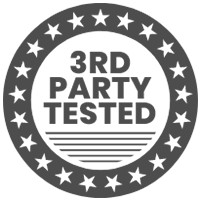45% Off Everything*
Save Now!!

Availability: In stock

| Unit Size | 2 mg/vial |
| Unit Quantity | 1 vial |
| Purity (Mass Spectrometry and UV) | 99.1% |
| Sequence | His-D-2-Me-Trp-Ala-Trp-D-Phe-Lys-NH2 |
| Molecular Formula | C47H58N12O6 |
| Molecular Mass | 886.45 |
| Appearance | Lyophilized White Powder |
| Source | Chemical Synthesis |
| Storage |
Lyophilized HEXARELIN is Stable at room Temperature for 90 days, however it is best to store in a freezer below - 8c for any extended period of time. After reconstitution HEXARELIN should be refrigerated at temperatures not to exceed 35 F. |
| Terms | The products we offer are intended for laboratory research use only. Please familiarize yourself with our terms of service prior to ordering. |
Hexarelin is a synthetic analog of the gastrointestinal peptide ghrelin. It binds to and subsequently activates the growth hormone secretagogue receptor (GHS-R) found in the brain and cardiovascular system.1 Specifically, hexarelin bind to GHS-R 1a, which is located in the pituitary gland and hypothalamus in the brain, along with the digestive tract, bone, prostate, heart, fat, and adrenal glands.1 When GHS-R 1a is activated, it releases growth hormone. Unlike ghrelin, hexarelin also binds to the CD36 receptor.1 Hexarelin contains 6 amino acids and has a molecular weight of just over 886 g/mol, making it a fraction of the size of ghrelin which contains 28 amino acids.1 It has similar effects and efficacy to ghrelin as a potent growth hormone release peptide, demonstrated in both human and animal studies.2 However, hexarelin is more chemically stable and has approximately double the half-life of ghrelin (55 minutes and 27 minutes, respectively).3,4 With this, hexarelin is a highly useful in vitro and in vivo peptide for studying ghrelin-related pathways. Hexarelin is known to have positive effects on the cardiovascular, gastrointestinal, muscular, and nervous systems. In studies, hexarelin reduces cardiac fibrosis in mouse models of myocardial infarction due to its interaction with the angiotensin-converting enzyme (ACE) system.5 The peptide also exhibits protective effects when treating acute respiratory distress syndrome (ARDS) and acute myocardial ischemia and reperfusion injury.6 These effects are likely due to anti-inflammatory mechanisms, as demonstrated by the reduced recruitment of inflammatory immune cells to the lungs in mouse models. Hexarelin also inhibits collagen deposition in models of lung fibrosis.5 In addition, hexarelin has protective effects at the mitochondrial levels in skeletal and cardiac muscles in vitro. The peptide inhibits hydrogen peroxide-induced apoptosis in Neuro-2A cells (a murine neuroblastoma cell line) by blocking the upregulation of MAP kinases.6
Hexarelin comes as a lyophilized white powder with a concentration of 2 mg/vial.
References: 1.Mao Y, Tokudome, T, Kishimoto I. The cardiovascular action of hexarelin. J Geriatr Cardiol. 2014 Sep;11(3):253-258. 2. Massoud AF, Hindmarsh PC, Matthews DR, Brook CG. The effect of repeated administration of hexarelin, a growth hormone releasing peptide, and growth hormone releasing hormone on growth hormone responsibility. Clin Endocrinol (Oxf). 1996 May;44(5):555-62. 3. Imbimbo BP, Mant T, Edwards M, Amin D, et al. Growth hormone-releasing activity of hexarelin in humans. A dose-response study. Eur J Clin Pharmacol. 1994;46(5):421-5. 4. Akamizu T, Takaya K, Irako T, Hosoda H, et al. Pharmacokinetics, safety, and endocrine and appetite effects of ghrelin administration in young healthy subjects. Eur J Endocrinol. 2004 Apr;150(4)447-55. 5. Zambelli V, Rizzi L, Delvecchio P, Bresciani E, et al. Hexarelin modulates lung mechanics, inflammation, and fibrosis in acute lung injury. Drug Target Insights. 2021 Jan-Dec;15:26-33. 6. McDonald H, Peart J, Kurniawan ND, Galloway G, et al. Hexarelin targets neuroinflammatory pathways to preserve cardiac morphology and function in a mouse model of myocardial ischemia-reperfusion. Biomed Pharmacother. 2020 Jul;127:110165.